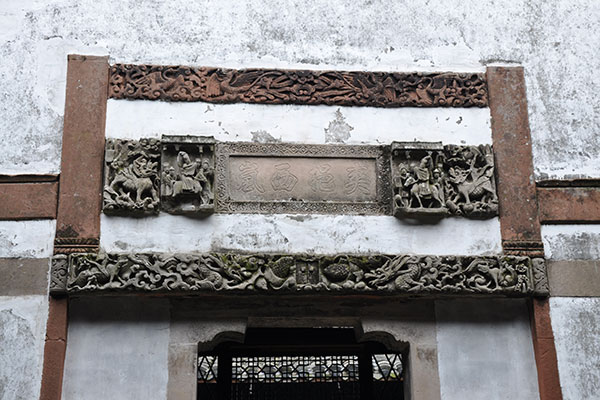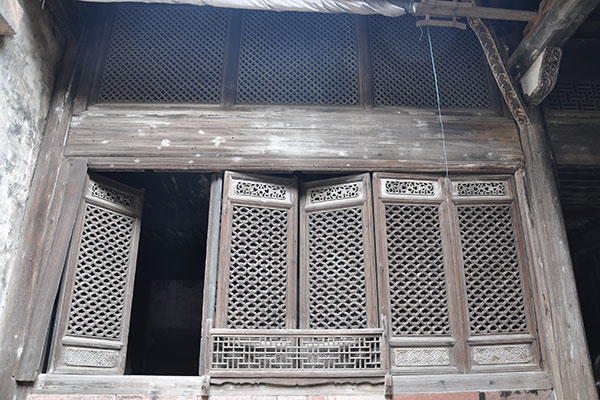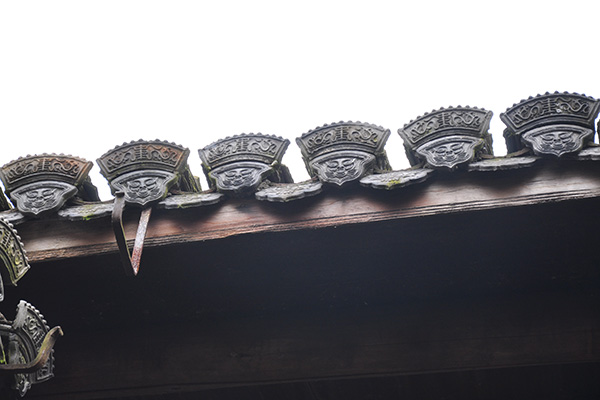
The streets and architecture of the Ming and Qing dynasties (1368-1911) still retain their old look in the villages of Luotian, Shuinan and Jingtai in Anyi county, in Nanchang, Jiangxi province.[Photo by Shi Xiaofeng/China Daily]
Steeped in the culture of China’s imperial era, a trio of communities in Jiangxi province offer a quiet look back at simpler times. Liu Xiangrui and Shi Xiaofeng go exploring in Nanchang.
While strolling in a maze of stone-paved lanes that crisscross the ancient villages of Luotian, Shuinan and Jingtai in Anyi county, in Nanchang of Jiangxi province, it’s easy to feel lost in time.
More than 100 residences from the Ming and Qing dynasties (1368-1911) are well-preserved in the villages, with ancient archways, gate towers, streets, lanes, stone wells and performance stages spread all over.

[Photo by Shi Xiaofeng/China Daily]
During a late-autumn visit, we enjoyed the tranquil moments of village life and the villages’ exquisite architecture that represented typical folk residences in Jiangxi region.
Only 300 meters apart and sitting like three legs of a tripod topographically, each of the villages has its own appeal and tells a unique story.
The village of Luotian was founded more than 1,120 years ago by Huang Kechang, who arrived while fleeing war and named the settlement after his original home — Luotian county in Hubei province.
Huang’s offspring flourished here, and many of them established new villages in other parts of Jiangxi later.
A giant camphor tree, sitting on a high point of the mountain backing the village, is said to have been planted by the village founder himself.
A tale has it that a grateful Huang planted the tree as a memorial after he had the luck to dug out treasures that weighed 150 kilograms on the spot.
Now the millennium-old tree has a diameter of 2.8 meters-it takes a circle of at least six people to reach their arms around it.
Spreading out its canopy like a giant umbrella and overlooking the village, the tree has witnessed the village’s glorious past.

[Photo by Shi Xiaofeng/China Daily]
The village sits along the most important traffic route to Nanchang, the provincial capital.
Tracks from repeated grinding and pressing of one-wheeled carts are still clearly visible on the granite pavements, leading us to imagine the busy scenes of the streets of old.
First built in the overlapping Song (960-1279) and Yuan (1271-1368) dynasties, the village’s three main streets flourished in the Qing Dynasty (1644-1911) when merchants and travelers filed through.
About 3 meters wide each, the streets form a U shape and encircle more than half of the village. The Front Street is most well-preserved: About 200 meters long, it has kept its ancient look, with stores lining both sides even today.
Sewage channels under its granite-slab pavement, first built in the Song Dynasty and incessantly extended over the centuries to form a complete network, still serve well.
During the Qing Dynasty, many village residents turned to business. Some of them opened stores along the streets while some ventured to other parts of China to set up shops.
Within decades, there were more than 20 “billionaires” among the Huang clan descendants. They established stores of good reputation one after another in the outside world, and also built complex mansions back in the village.
The grand mansion of Huang Xiuwen, the 27th generation of Huang Kechang, has the largest scale and finest craftsmanship. Located at the crossing of Back and Horizontal streets, its construction started in 1751 and lasted 38 years, even after Huang’s death.
The mansion had a symmetrical layout, with five rows in depth. It once occupied a total of 5,500 square meters, with 12 halls, 36 pairs of wing rooms and 108 sitting rooms, as well as 48 courtyards.

[Photo by Shi Xiaofeng/China Daily]
Most parts of the mansion, which has been listed as a protected relic site by Jiangxi province, have been preserved.
Besides the lofty and spacious halls, you are unlikely to miss the many exquisite wooden and stone carvings in the ancient houses. For the house owners, they were not only nice decoration, but rich with connotations of well-known historical stories and symbols of good luck.
Many ancient stone wells are still in use in Luotian. Villagers love brewing tea with water from the Longevity and Health Well, the first well dug by their ancestors here. They believe its water gives them health and long lives.
Shuinan village was established by one of Huang Kechang’s descendants, next to Luotian about 500 years after that village’s founding.
Shuinan has more than 20 well-kept ancient buildings from the Ming and Qing dynasties. The village is best known for its exquisite carvings in the old houses and large collection of traditional pieces in its folk museum.
One attraction in Shuinan village is the Young Lady’s Tower, where the daughter of a rich landlord led her daily life. Composed of a beautifully decorated hall and corridor towers, it was here that the daughter of the master threw a colorful ball to select her bridegroom, according to the interesting story told for hundreds of years.
Jingtai village was founded about 1,400 years ago by two brothers of the Liu clan, who moved here to escape from war. Later the Li clan moved in and they have lived together peacefully since. With a long history and many ancient buildings remaining, the village has become a popular site for film and television shooting.
The three villages’ richness in relics is believed to be the result of centuries of strong focus on culture and education.
Farmers studied when they were not working in their fields. They not only built good schools within the villages, but also spared no expense to employ good teachers for their young. Villagers were eager for their children to become educated, win scholarly honors and earn official ranks to glorify their ancestors.
Thanks to that, the three villages fostered a number of successful candidates in the highest imperial examinations, and over 300 officials of high or low ranks. The achievements earned respect for the clans in the villages from people near and far.
Over the centuries, many kinds of folk arts, such as the tea-picking opera, high-tune gongs and drums and dragon lantern performance flourished in the villages as well. They still play an important role in the villagers’ cultural life today.
If you go
Situated in the southeastern part of Anyi county in the suburbs of Nanchang city, the ancient village group of Anyi is 35 km from Nanchang Airport. The No 105 State Highway directly reaches the ancient villages.
